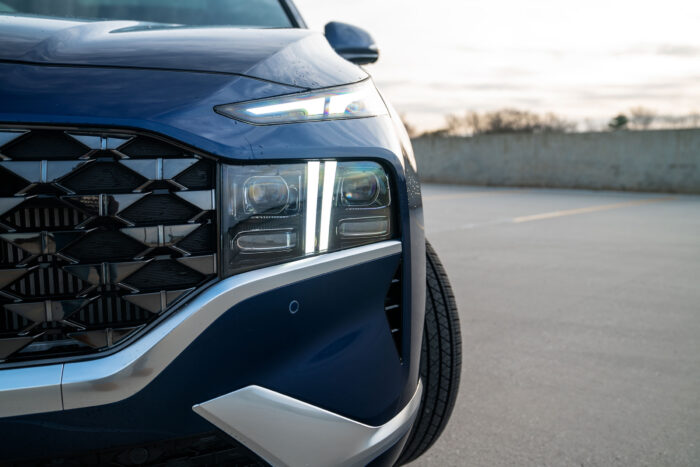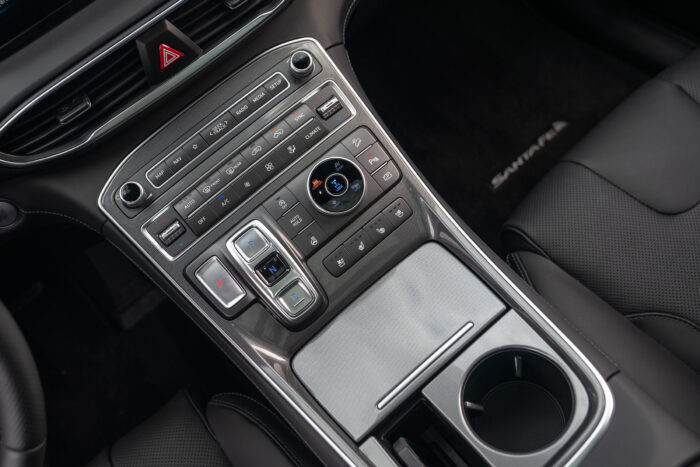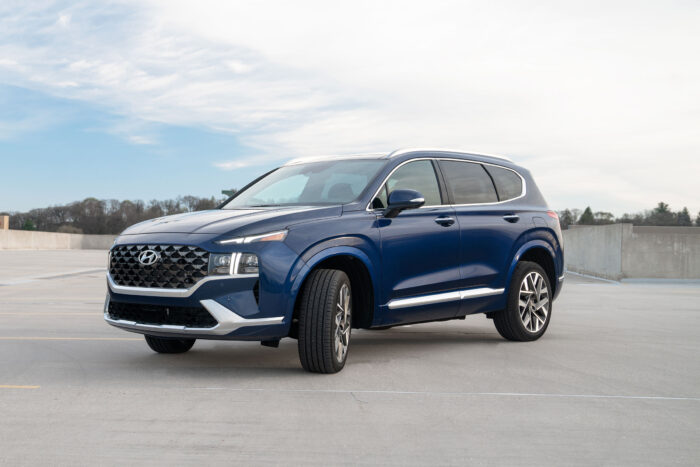Hyundai has been making a lot of headlines recently. Every time I talk to someone about the Korean automaker, one of two things happens: they either bring up the infamous Tik-Tok challenge or they marvel at all the positive feedback they’ve gotten from owners and other car journalists.
The good news for consumers is that Hyundai and Kia have put the theft issue to rest. It’s not a problem anymore. As for the value proposition, it’s all true. Hyundai dealerships are great places to score a good deal on a quality car.
We grabbed the keys to one of the brand’s bestselling vehicles, the 2023 Hyundai Santa Fe — our test model came in the top-spec Calligraphy trim — to see how it handles daily driving and determine exactly how much car you get for the $45,255 sticker price (as tested). The shakedown would include city commuting, long highway miles, and an unexpected April snowstorm.
In short: Hyundai isn’t afraid to try new things, and creative approaches to common problems make the 2023 Hyundai Santa Fe a better SUV, especially in the Calligraphy trim. Not only will you get a comfortable cabin packed with technology, but you’ll also spend less than the average car buyer to get it. Just be realistic about the kind of adventure you choose to pursue in one.
- Engine: 2.5L Turbocharged Inline Four
- HP/Torque: 281/311
- MPG: 21/28/24 City/Highway/Combined
- Cargo: 36.4 cubic feet (72.1 w/ second seats folded)
- Towing: 3,500 lbs. w/ trailer brake (1,650 lbs. on base)
Pros
- Luxurious interior
- Responsive turbocharged engine
- Family-friendly features
- Quality infotainment system
- Large, well-organized cargo area
- Great value
Cons
- Slow gear changes from the transmission
- Adventure-seeking marketing language is a bit optimistic
2023 Hyundai Santa Fe Calligraphy Review

Styling That’s Uniquely Hyundai
Hyundai has worked hard in recent years to modernize its designs and establish its vehicles as something we desire — not something we settle for. The effort has paid off by making everything from the sporty Veloster N (may it return to us soon) to the range-topping Palisade look fresh and appealing.
The 2023 Hyundai Santa Fe isn’t pushing the envelope as hard as the brand’s Ioniq 5 EV, but it’s instantly recognizable as a Hyundai thanks to unconventional headlights and a grille pattern that’s carried across several models in Hyundai’s lineup.
The Santa Fe’s boxy shape is surprisingly aerodynamic. Hyundai claims a drag coefficient of 0.33, which puts the Santa Fe right between a 997-generation Porsche 911 GTS and a Ford Focus RS — not too shabby for a square-nosed SUV with such a commanding view of the road.
Light & Space Define a Luxurious Interior

I’ve heard that luxury is defined by light and space. Anyone who’s worked in a cubicle can confirm that. Hyundai must be aware of this because the Santa Fe’s designers pulled out all the stops with the Calligraphy trim to maximize the sensation of open space while isolating occupants from unwelcome road noise.

Light floods the Santa Fe’s interior via the panoramic sunroof. You can open the glass for airflow or close the sunshade to block off the glass entirely. Between this, the uncluttered dash, plenty of cubbies to organize cargo, and good visibility, I felt like I was in a much larger vehicle than the Santa Fe’s 109-inch wheelbase and 75-inch width would suggest.

Copious use of Nappa leather, a heated steering wheel, heated and ventilated front seats, and wireless phone charging are all nice, too. Even the second row gets heated seats, sunshades, and individual USB chargers.
Polarizing Center Control Interface
Some drivers will take issue with the buttons that control the transmission, but I don’t mind them. This approach allowed Hyundai to create a smooth, uncluttered center control panel that keeps everything you need right at your fingertips.

Want to turn on the heated or cooled seats? There’s a separate button for each — no need to dive into a complicated menu on the touchscreen. The same goes for switching between navigation and entertainment screens, adjusting the climate control, and selecting one of the four available drive modes. All the buttons are neatly organized by function, and I’d much rather memorize their layout than have to take my eyes off the road to use a touchscreen all the time.
Some people will love this layout; others will be turned off by it because it’s unconventional. I think if you give it an honest chance, you’ll find it more user-friendly than most of the alternatives in modern cars.
The 2023 Hyundai Santa Fe Makes Life Easier
The best parts about the 2023 Hyundai Santa Fe aren’t on a spec sheet. Little details throughout the vehicle combine to make it an SUV that becomes a pleasant part of your day.

On the road, the Santa Fe’s tech acts as a second set of eyes. Lane-keeping assistance and adaptive cruise control are nothing new, but cameras that display the vehicle’s blind spots in the gauge cluster can be very helpful and keep your attention in front of the car. Another subtle feature is the navigation audio, which cuts music to the front speakers to deliver turn-by-turn cues while allowing music to play in the rear.

Some of the Hyundai’s digital features can be customized. Fill up the head-up display with information, pick and choose the specific information you want, or turn it off altogether. Program the key fob to open the tailgate as you approach the vehicle or use the manual latch — the choice is yours.

Inside, the Santa Fe’s storage cubbies keep the cabin well-organized. There are cupholders and charging ports for everyone. The cargo area offers 36.4 cubic feet of storage with the seats raised, 72.1 cubic feet with them flat, and there are three storage compartments under the cargo area floor. Rear seat release buttons let you lower the second row from outside the cargo area, although you’ll have to raise them manually from each side.
Surprisingly Athletic

The 2023 Hyundai Santa Fe is not a sports SUV by any stretch of the imagination, but it’s no slouch, either. The turbocharged 2.5L engine pushes out 281 horsepower and 311 pound-feet of torque via an eight-speed dual-clutch automatic transmission, and it’s tuned to deliver that thrust early in the rev range. The result is an SUV that can scoot around town and overtake trucks on the highway without making you wait for the engine to spin up and kick down a gear.
On our test model, that power can turn all four wheels via Hyundai’s HTRAC all-wheel-drive system. Under normal road conditions, the system operates as front-wheel drive. When the vehicle detects wheelspin, it can route up to 50% of its power to the rear wheels.
The drive mode selector dial has a center lock button. This isn’t the same kind of locking differential that you’d get in something like a Land Cruiser; instead, it sends a minimum of 20% of available power to the rear at all times with the ability to reach the same 50/50 split.
Either way, HTRAC monitors 50 vehicle inputs more than 100 times per second to take the guesswork out of driving the Santa Fe on slippery surfaces.

Be Patient With the Transmission
One part of driving the Santa Fe that I don’t enjoy is the transmission response time. The buttons don’t bother me — switching gears with a computer is nothing new — but I want the transition between reverse and drive to happen quicker.
The Santa Fe sounds an audible signal when the gear change is completed so you don’t have to keep an eye on the gauge cluster. But, I still find myself backing out of my driveway onto a busy street, tapping drive, and wanting to pull away before the transmission is ready. If Hyundai can find a way to speed this process up, drivers really won’t have anything to complain about.
Take Marketing Lingo With a Grain of Salt
Hyundai’s website calls the Santa Fe “the adventurous family SUV” and boasts that it offers “refinement for even the most rugged miles ahead.” For most people, this will hold true. When equipped with HTRAC all-wheel drive, and a good set of tires, the Santa Fe can generally get you where you need to go.
If you’ve ever modified a 4Runner or Jeep because the factory equipment was holding you back on the trails, this claim obviously isn’t aimed at you. “The most rugged miles ahead” probably refers to a maintained road that got a little snow overnight or has a few extra potholes from heavy rain.

2023 Hyundai Santa Fe Calligraphy Review: Conclusion
One of my litmus tests for a vehicle is to sit in the driver’s seat and read the sticker price on the Monroney — a printout of the window sticker. If I had paid $45,255 to get behind the wheel of the 2023 Hyundai Santa Fe Calligraphy, I’d feel very good about my purchase. It’s a lot of vehicle for the money.
The Santa Fe, like most five-seat SUVs, has to do a lot of jobs well. We demand that it be safe, affordable, comfortable, and enjoyable to drive. Hyundai nailed it with this one. It checks all the boxes.









